Posted by Leslie Orgel on 04-30-2003 10:45 AM:
Mafrash Panel with Chromosomes
Hello All,
Here is a Mafrash Panel depicting a Chromosome Spread, just
to back up Patrick Weiler’s speculations about early Persian geneticists.

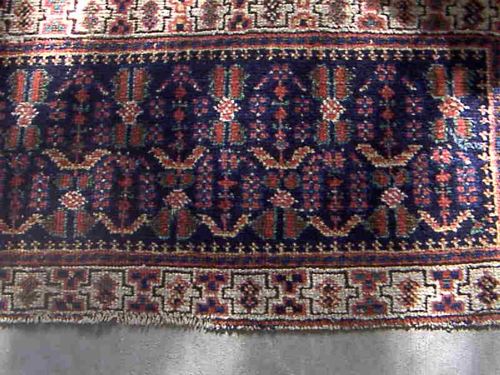
I don’t remember seeing a rug
with helices. Any references to other chromosome rugs would be appreciated.
Best wishes,
Leslie.
Posted by Patrick Weiler on 05-01-2003 12:46 AM:
X-men
Leslie,
Are you sure that is a mafrash panel? It seems a bit long for
that. It looks more like a section of what has been called a "box cover".
Perhaps a box cover for bio-genetic experiments, though. It looks like some of
your X chromosomes are deforming 
Do you know where it was made? The box covers I am familiar with
are Kurdish. ( Of course, the Kurds and Lurs were neighbors)
Are there any
repairs to the weaving at either side near the middle? This, too, is an
identifying characteristic I have seen in these box covers, almost as though
there had been an attaching device which has been removed and repaired.
The
little crosses surrounding the field even look a bit like the diamonds
surrounding the medallions on the "chromosome" rug in the Salon:
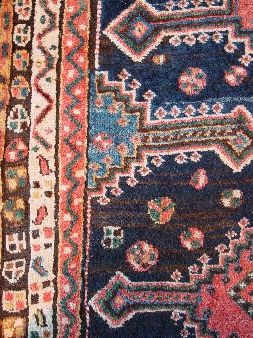
Patrick Weiler
Posted by Leslie_Orgel on 05-01-2003 11:05 AM:
Hello Patrick,
Thank you for your interesting suggestion. I didn't
know about "box covers". My only reason for thinking that the piece was a
mafrash panel was its size (39 inches by 15 inches) and the attribution of the
dealer who sold it to me. There doesn't seem to be any damage to the middle of
the sides. Azadi and Andrews, in their book "Mafrash", show two Afshar pieces
that are as long or longer than mine, but most of their pieces are significantly
shorter.
I have always assumed that the panel is Kurdish. If that is
correct, it would fit nicely with your suggestion of a box cover. Incidentally,
the warps are cotton. Is that significant?
Leslie
Posted by Patrick Weiler on 05-02-2003 12:25 AM:
Cotton is Good
Leslie,
Harken back to good, old Salon 42...... It was a dark and
stormy night...
http://www.turkotek.com/salon_00042/s42t1.htm
You will
see a box cover of remarkable resemblance to your panel. It, too, is woven on a
cotton foundation. That cotton foundation may indicate a village or city origin.
The Salon itself shows two panels of one of these box covers, woven on a
wool foundation.
Patrick Weiler
Posted by Leslie_Orgel on 05-02-2003 11:31 AM:
Patrick.
I think that the resemblance between my panel and the mystery
piece in Salon 42 is so close that they must be parts of the same class of
textile. A box cover seems the most likely and a mafrash panel unlikely. Thank
you for for so much really useful information.
Leslie
Posted by Patrick Weiler on 05-12-2003 06:23 PM:
Another Box Cover, 2 Panels
Leslie,
Here is another box cover section. It has wool warp and weft.
It has a top panel much like your chromosome panel, but with a lower panel, too.
(therefore it is worth exactly twice as much as yours!):
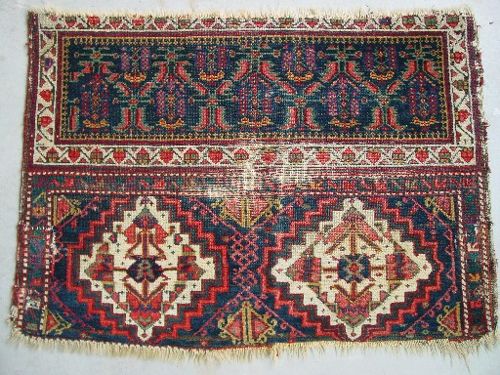
It has the same
boteh-in-chromosome lattice as yours. This one appears to have a bug-head with
two eyes, a nose and a mouth, with antennae sticking out. The bottom of some of
the boteh's appear to be oppositely swimming yellow ducks:
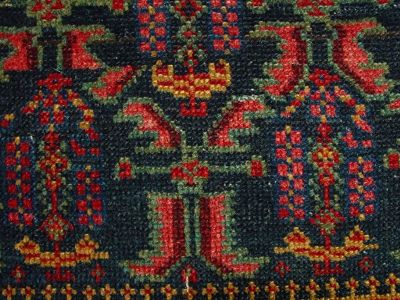
But it also has a second panel
with two very geometricized floral medallions:
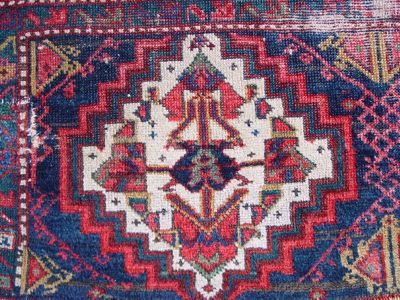
You can also see the repair at
the left side I mentioned. It has a similar repair on the right side, too. I
suspect that the second panel from your piece may have had these damaged
sections but it was cut off because it was easier to dismember than to repair. I
suspect that some kind of closure or tie-down strap was attached at these points
and their corresponding points on the other end of the cover. Because the middle
section was very plain, the market place may have separated the top and bottom
sections for sale and either discarded the middle section, or put a fringe on it
and sold it as a mat.
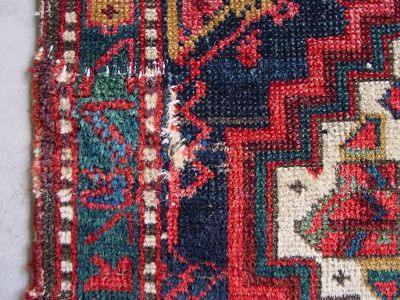
One odd feature about these box covers is that each panel has a
complete border surrounding it. The upper panel of mine has what I call a
"pencil" border. These panels must have been visible in their entirety-on
different "sides" of whatever box they were covering. What kind of box was
it?
Patrick Weiler








